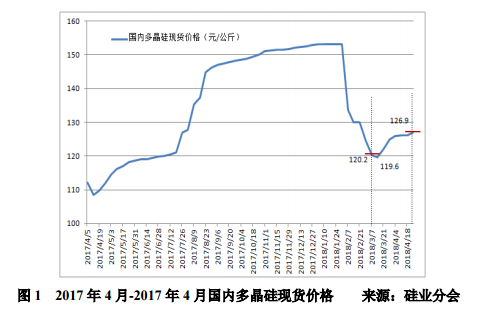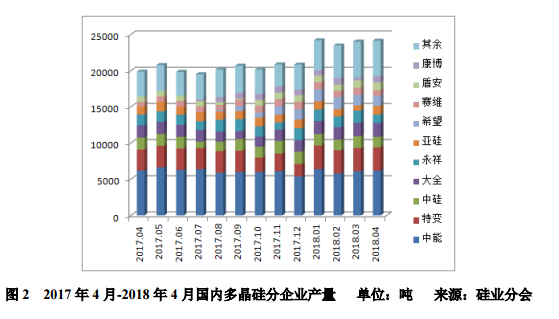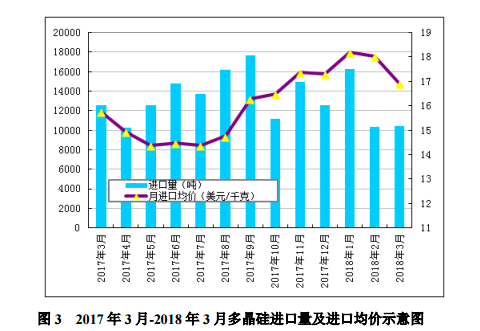First, the price of polysilicon is slowly rising. In the first three months of 2018, the price of polysilicon rebounded slowly. At the beginning of March, the transaction price of solar first-class dense materials bottomed out at 120,200 yuan/ton. In the second week, the rebound rebounded to 126,900 yuan/ton at the end of April, an increase of 5.6%. The average price in April was 126,300 yuan / ton, an increase of 3.8%. Reasons for supporting the rebound in polysilicon prices: The strong demand for domestic single crystals and the fierceness of overseas markets have stimulated the PV market in the second quarter. Polysilicon prices began to pick up slowly. On the one hand, the shortage of silicon stocks is difficult to meet the sharp increase in downstream demand, and on the other hand, the short-term price can be predicted. In the rising stage, the selling mentality has the upper hand, and the silicon material enterprises will not sign too many long orders in advance. The shortage of single crystal materials is higher than that of polycrystalline materials, and due to the improvement of monocrystalline silicon wafer processing technology, the supply of polysilicon currently available for single crystal materials in China has increased, so the volume of each transaction has increased while the transaction Prices have also picked up. Second, the resumption of production supply repair and repair gap According to statistics from the Silicon Industry Branch, as of the end of April 2018, there are 24 domestic polysilicon enterprises (including normal maintenance enterprises) with an effective capacity of 294,000 tons/year. Domestic polysilicon production in March-April totaled 48,200 tons, up 20.8% year-on-year, of which 2,400,000 tons were produced in March, and 24,200 tons were produced in April, up 2.1% and 0.8% respectively. The output of polysilicon in April increased slightly, mainly because the production release of Asian Silicon, Henan Hengxing and Jiangsu Kangbo repaired the post-production output of Luoyang Zhongsi, LDK, Kunming, and Inner Mongolia Dongli. In April, according to the output, Jiangsu Zhongneng, Xinte Energy and Xinjiang Daquan ranked the top three respectively, and the output of these three enterprises accounted for 46.8% of the total output. The top eight companies with monthly output of more than 1,000 tons are: Zhongneng, Xinte, Daquan, Zhongsi, Dongfang Hope, Yongxiang, Asia Silicon, and Dunan. The total output of these eight enterprises accounts for 72.8% of the total national output. Judging from the production situation of various enterprises, Jiangsu Zhongneng, Xinte Energy and Xinjiang Daquan have no maintenance and overhaul plans in the short term; Sichuan Yongxiang adjusts the load and the output is slightly reduced; Asia Silicon Industry, Henan Hengxing and Jiangsu Kangbo three maintenance enterprises in March Both returned to normal production in the first week of April; Luoyang Zhongwa and Kunming Yeyan were partially supplied due to equipment maintenance; Saiwei LDK and Inner Mongolia Dongli cold hydrogenation equipment were overhauled, and the output was slightly reduced; Inner Mongolia Dunan was at 10,000 tons/ On the basis of the effective production capacity of the year, the output has further improved, and it has jumped into the ranks of 1,000-ton enterprises with monthly output; Tianhong Ruike has gradually stabilized its operation after production, and the output has been further released. The remaining silicon materials companies maintained normal production. Third, South Korea imports return to the top According to the latest statistics from the customs, the import volume of polysilicon in March 2018 was 10,432 tons, an increase of 1.3% from the previous month. The average import price in March was US$16.90/kg, a decrease of 6.3% from the previous month. It is worth noting the following three points: First, imports from South Korea returned to the top. In March, the import volume from South Korea was 4,120 tons, a substantial increase of 45.8% from the previous month, and the proportion of total imports was still as high as 39.5%. The reason for the sharp increase in imports from South Korea is that the domestic polysilicon market began to pick up in March, driving overseas demand. On the other hand, the supply of Korean companies has improved after the inspection and production. Second, imports from Germany have fallen sharply. In March, the import volume from Germany was 2,463 tons, a sharp decrease of 46.1% from the previous month, accounting for 23.6% of the total import volume, and still ranked second in the import volume. The customs data in March showed that the German import volume decreased because the German WACKER in February has already A large amount of polysilicon material was imported into the Shanghai warehouse for storage, so the import volume decreased significantly in March. Third, imports from Taiwan and Malaysia remain high. In March, 1,887 tons of polysilicon was imported from Taiwan, accounting for 18.1% of the total imports in March, accounting for a record high, ranking third in domestic imports. In March, 1,225 tons were imported from Malaysia, accounting for 11.8% of the total imports in March, surpassing the United States in ranking fourth. By country: In March 2018, the import volume from the four regions of Korea, Germany, Taiwan and Malaysia was 9,965 tons, accounting for 92.9% of the total imports. The proportion of imports was 39.5%, 23.6% and 18.1% respectively. 11.8%, South Korea still ranks first in terms of imports. According to the trade mode: in March 2018, the import of polysilicon by processing trade was 2,493 tons, accounting for 23.9% of the total import volume, of which imports accounted for 77.9% of the bonded warehouses. Fourth, the cost advantage of large new construction projects is leading At present, the production cost of polysilicon mainly includes the following parts: power cost, depreciation cost, raw material cost, labor cost and other costs. According to the investigation of the Silicon Industry Branch, most of the polysilicon enterprises in China have completed the process of technological transformation and cost reduction, but due to the electricity prices of various enterprises. Different investment levels, different energy consumption costs and depreciation costs of enterprises still have different degrees of difference: Xinjiang, Inner Mongolia, electricity prices are relatively low, plus if the new projects, investment is late, domestic equipment is mostly, depreciation costs are relatively low . From the perspective of the development plans of various enterprises, new projects in the New Year are concentrated in areas with lower production factors, including: Jiangsu Zhongneng new 40,000 tons/year project to build two new 50,000 tons/year projects in Xinjiang and Tongwei. In Sichuan and Inner Mongolia, Xinte Energy has expanded its coal-fired silicon integration project in Xinjiang by 36,000 tons/year, Shaanxi Tianhong Ruike and Dongfang Hope, all of which are in energy-optimized areas, and other companies are striving for lower electricity prices. To enhance its competitiveness, including the electricity price in Inner Mongolia has dropped to around 0.25 yuan / kWh. With the advancement of process technology in various domestic production enterprises, the optimization of production technology indicators, the production cost of polysilicon enterprises has been greatly reduced, and it has maintained an absolute leading position among similar enterprises in the world. At present, the production cost of domestic polysilicon enterprises (including depreciation, excluding three fees) can be divided into three sections, 6-7 million yuan / ton, 7-8 million yuan / ton, 8-10 million yuan / ton, reducing power consumption The three intervals are: 44-50 degrees / kg, 50-55 degrees / kg, 55-60 degrees / kg. The cost of large-scale new projects with energy advantages is mostly concentrated in the first category. With the continuous innovation and improvement of technology, technical indicators and production costs still have the potential to continue to optimize. V. Polysilicon market outlook As of the end of April, the demand for single crystal materials is relatively tight, and under the premise of improving the processing technology of single crystal silicon wafers, the supply of polycrystalline silicon for domestic single crystal materials is gradually increasing, and the domestic transaction price has rebounded. . According to the current analysis of orders for silicon materials and wafer companies, most companies have signed some orders for May, and some companies have signed orders in June, and prices have remained stable and rising, but there is demand for polycrystalline silicon wafers and monocrystalline silicon wafers. The trend of "polarization", the demand for monocrystalline silicon wafers is strong, and the polycrystalline silicon wafers are unattended, resulting in a difficult balance of polysilicon prices, which is slightly different from the expected "630" grabs. Therefore, the growth rate of polysilicon prices is limited. . Geological Exploration Drilling Rig
Exploration Drilling Rigs are specialized equipment used primarily in the field of geological exploration, mineral prospecting, and environmental investigations. These rigs are designed to penetrate the Earth's surface to gather core samples, rock samples, soil samples, and other geological data. Key points about exploration drilling rigs include:
Geological Exploration: These rigs are vital for geological surveys and the collection of subsurface information. Geologists and mining companies use them to understand the composition, structure, and characteristics of the Earth's crust.
Mineral Exploration: In mining and mineral exploration, these rigs help locate and assess the potential value of mineral deposits, including precious metals, ores, and minerals. They play a crucial role in determining the feasibility of mining operations.
Environmental Assessments: Exploration drilling rigs are used to investigate soil and groundwater conditions, assess contamination, and monitor environmental impacts. They are valuable tools in environmental remediation and monitoring projects.
Core Sampling: They are equipped to retrieve core samples, which are cylindrical sections of rock or soil. These samples provide valuable information about geological formations, mineral content, and subsurface conditions.
Variety of Types: Exploration drilling rigs come in various types, including core drilling rigs, rotary drilling rigs, and percussion drilling rigs, each tailored to specific geological conditions and objectives.
Geological Research: These rigs are indispensable for academic and scientific research, helping researchers and geologists gain insights into Earth's history, structure, and resources.
In summary, exploration drilling rigs are essential tools for gathering geological data and are used in diverse applications, from mineral exploration to environmental studies and scientific research. They help make informed decisions in resource management, mining, and environmental protection.
Backpack Drill Rig,Backpack Drill Bit,exploration drill rig,Geological Exploration Drilling Rig,Exploration Drilling Equipment Hans Super Abrasive Diamond Tool Co.,Ltd , https://www.hansuperabrasive.com



May Polysilicon Monthly Review: Single Polycrystalline Demand Differences Polysilicon Growth Rate Limited
Abstract 1. The price of polysilicon rebounded slowly. The price of polysilicon in the period of March and March was slowly rising. In early March, the transaction price of the first-class dense material of solar energy bottomed out at 120,200 yuan/ton. In the second week, it rebounded to 126,900 yuan/ton at the end of April. The increase was 5.6%. April...